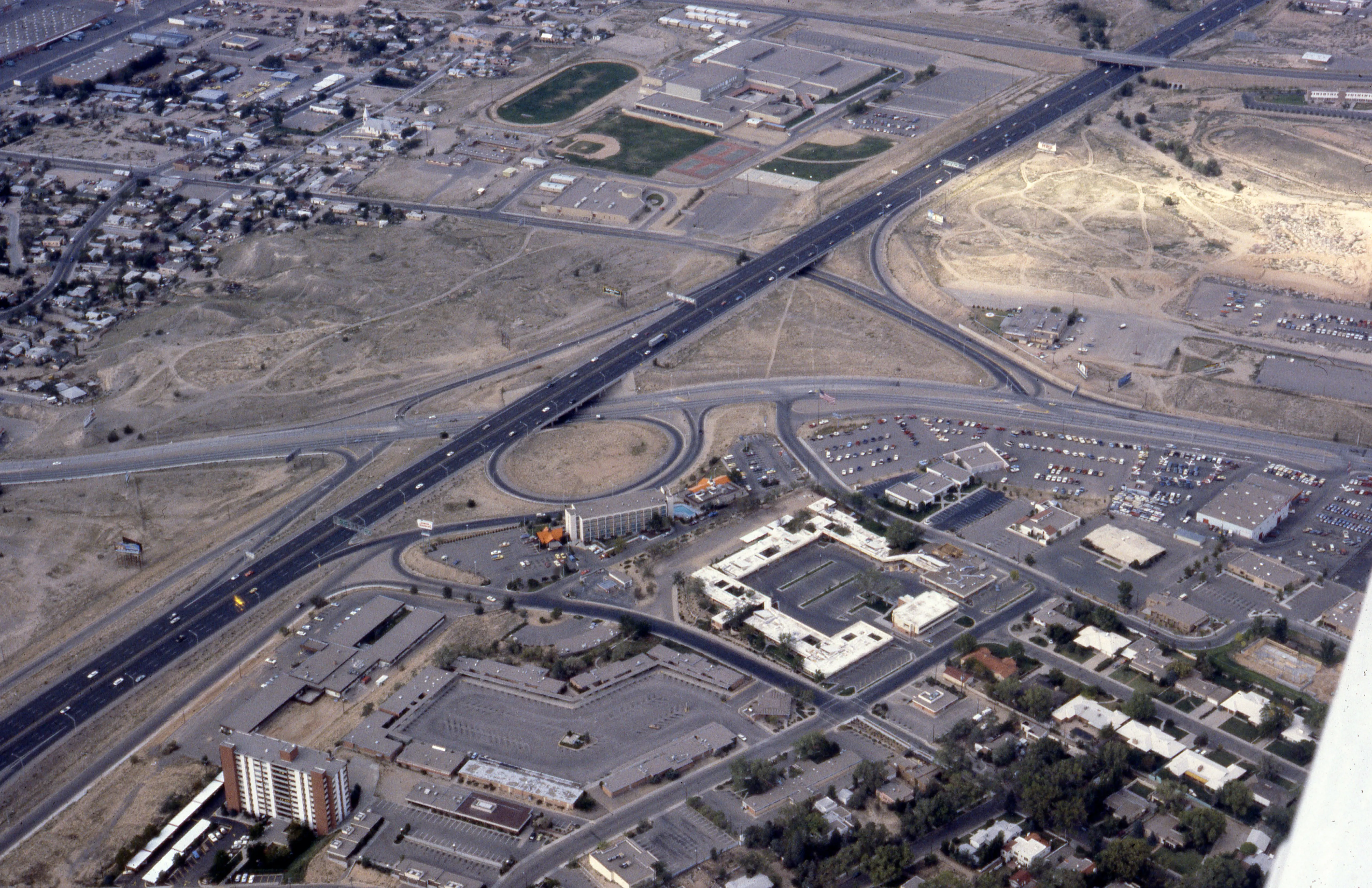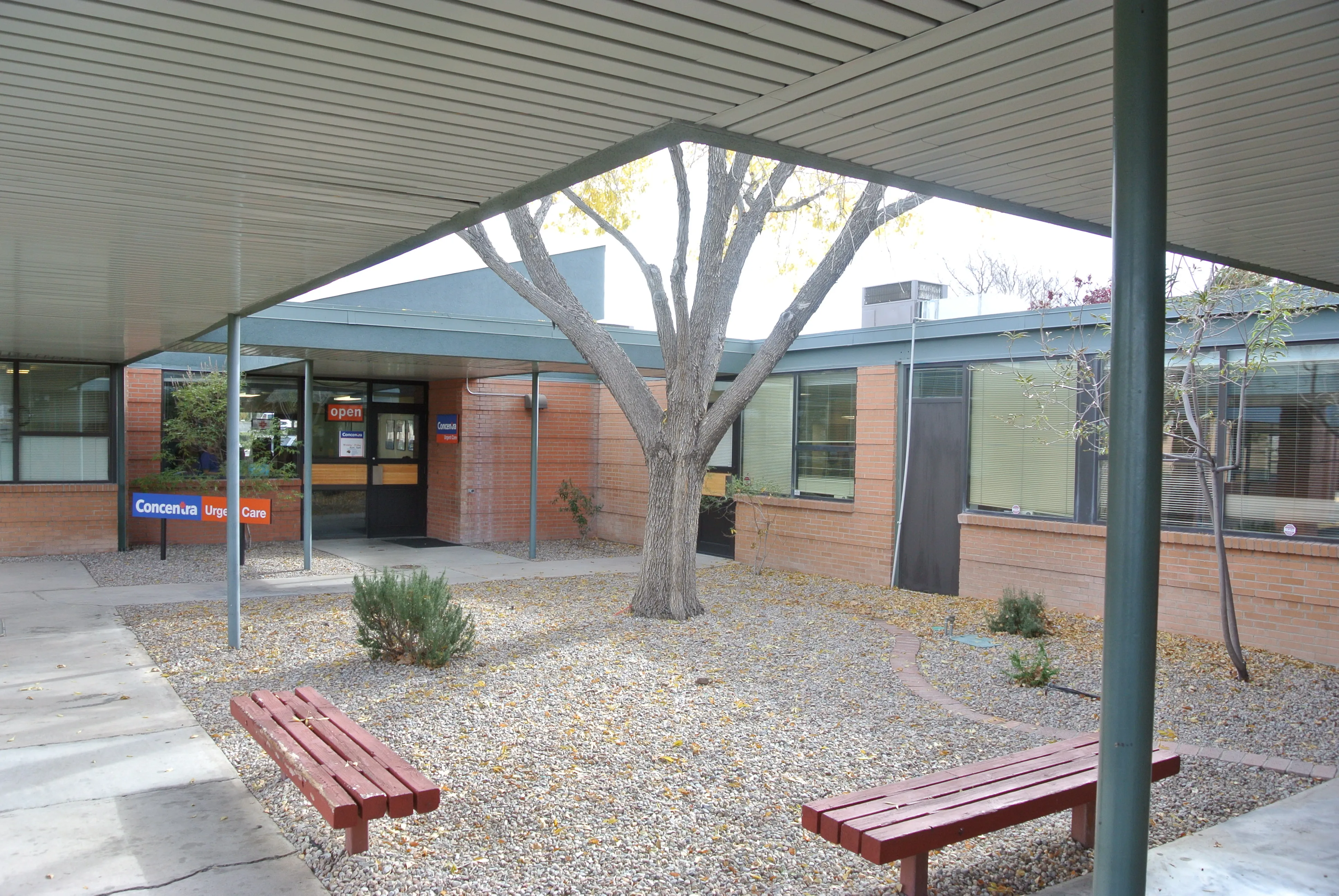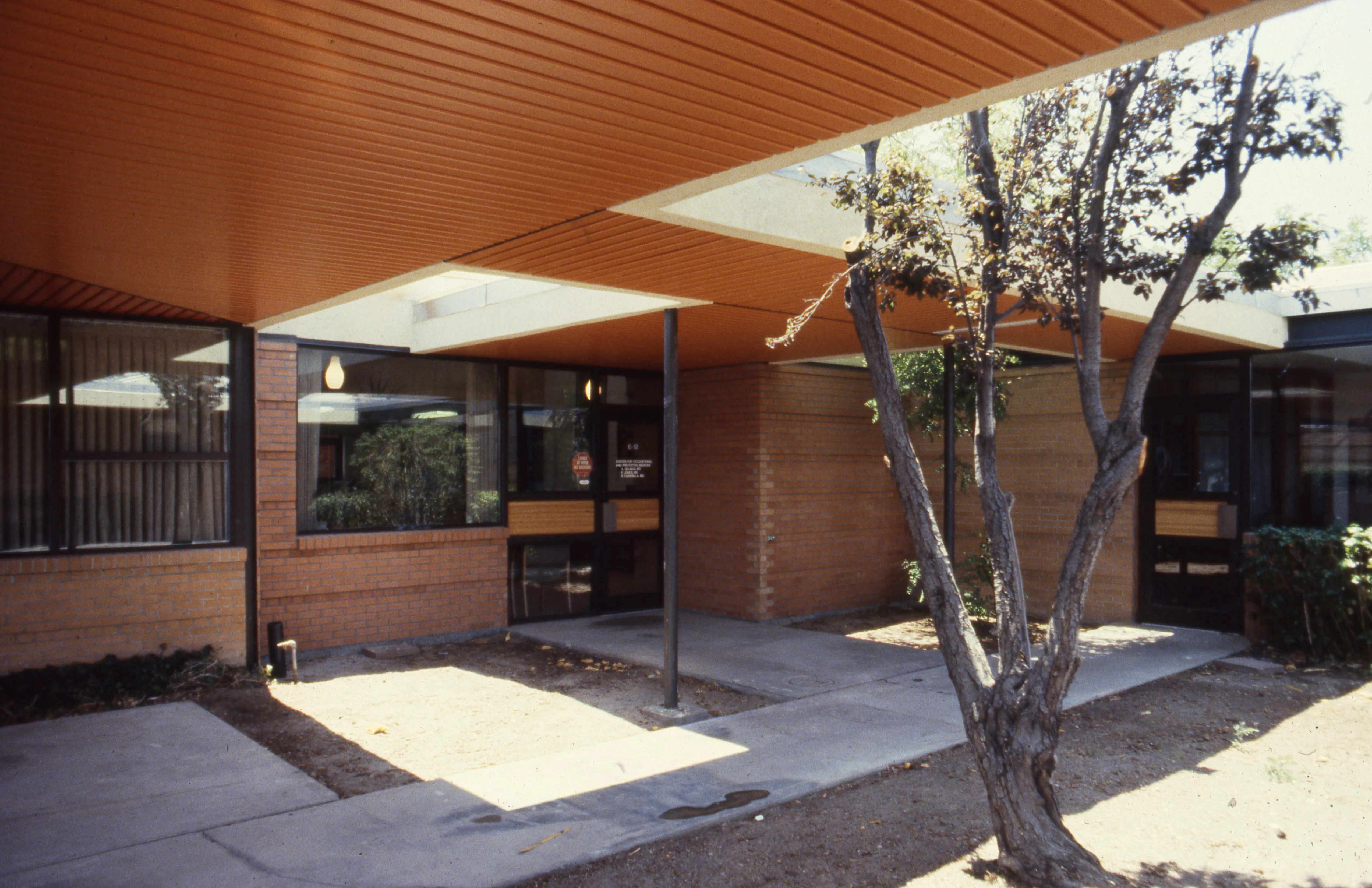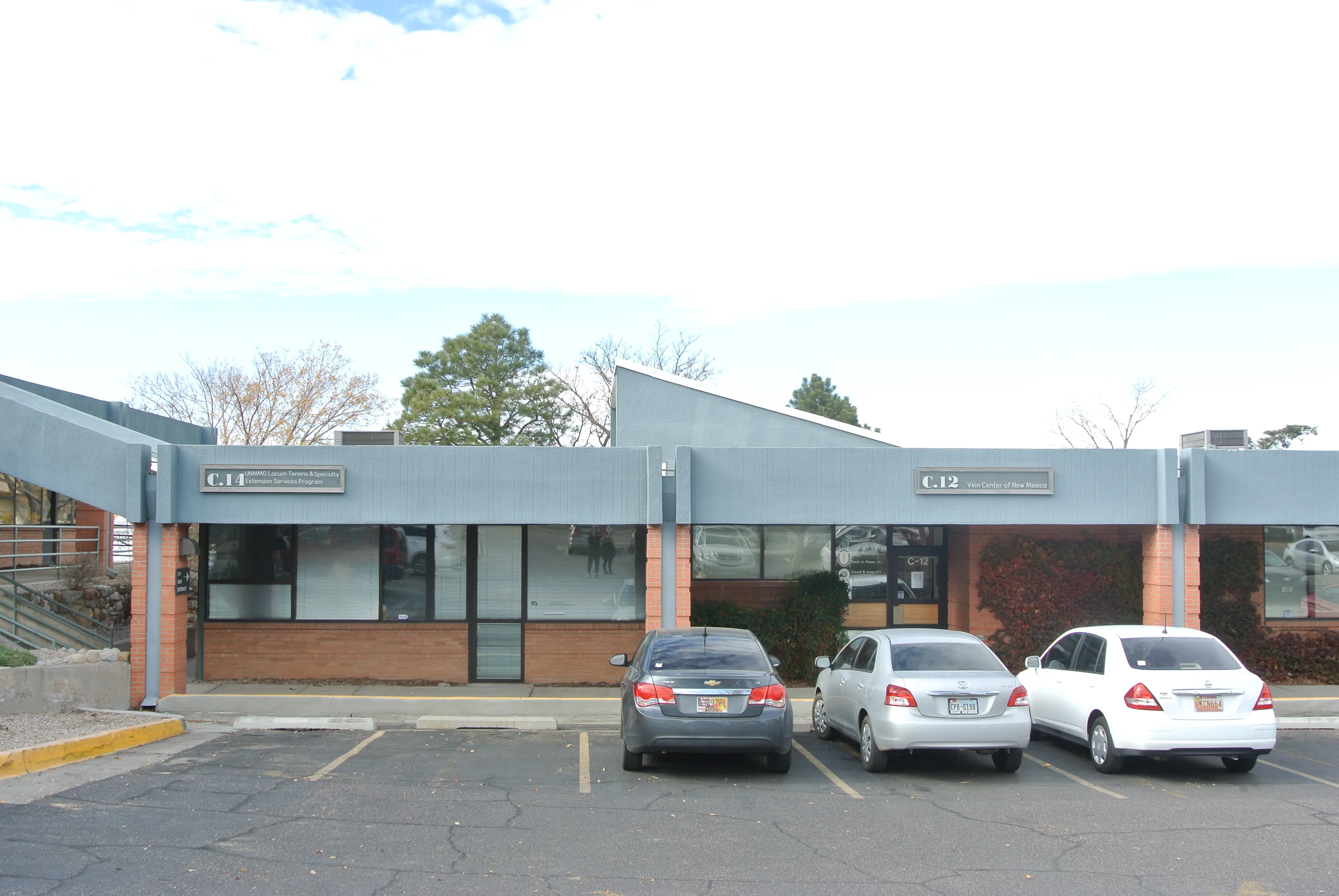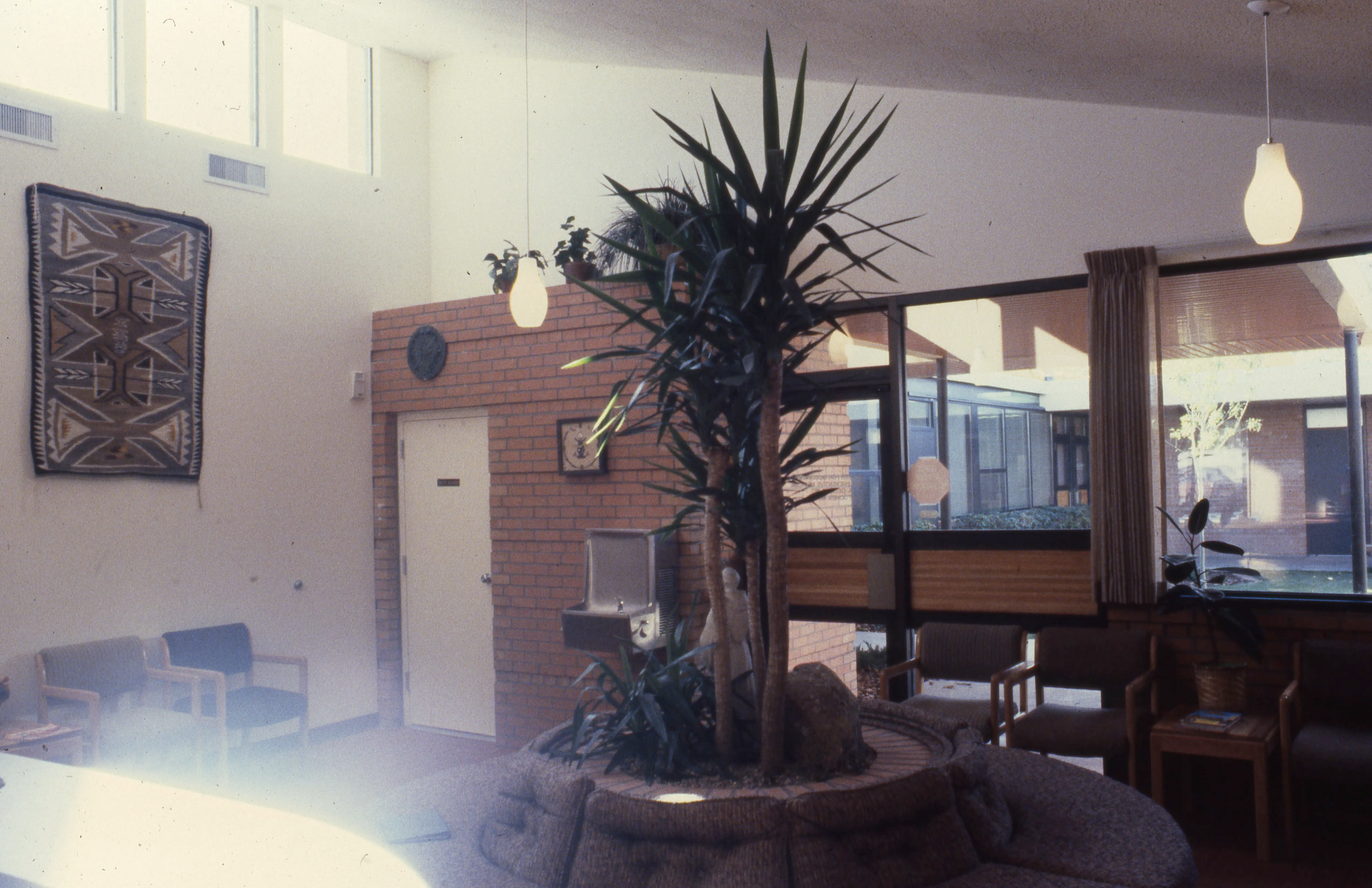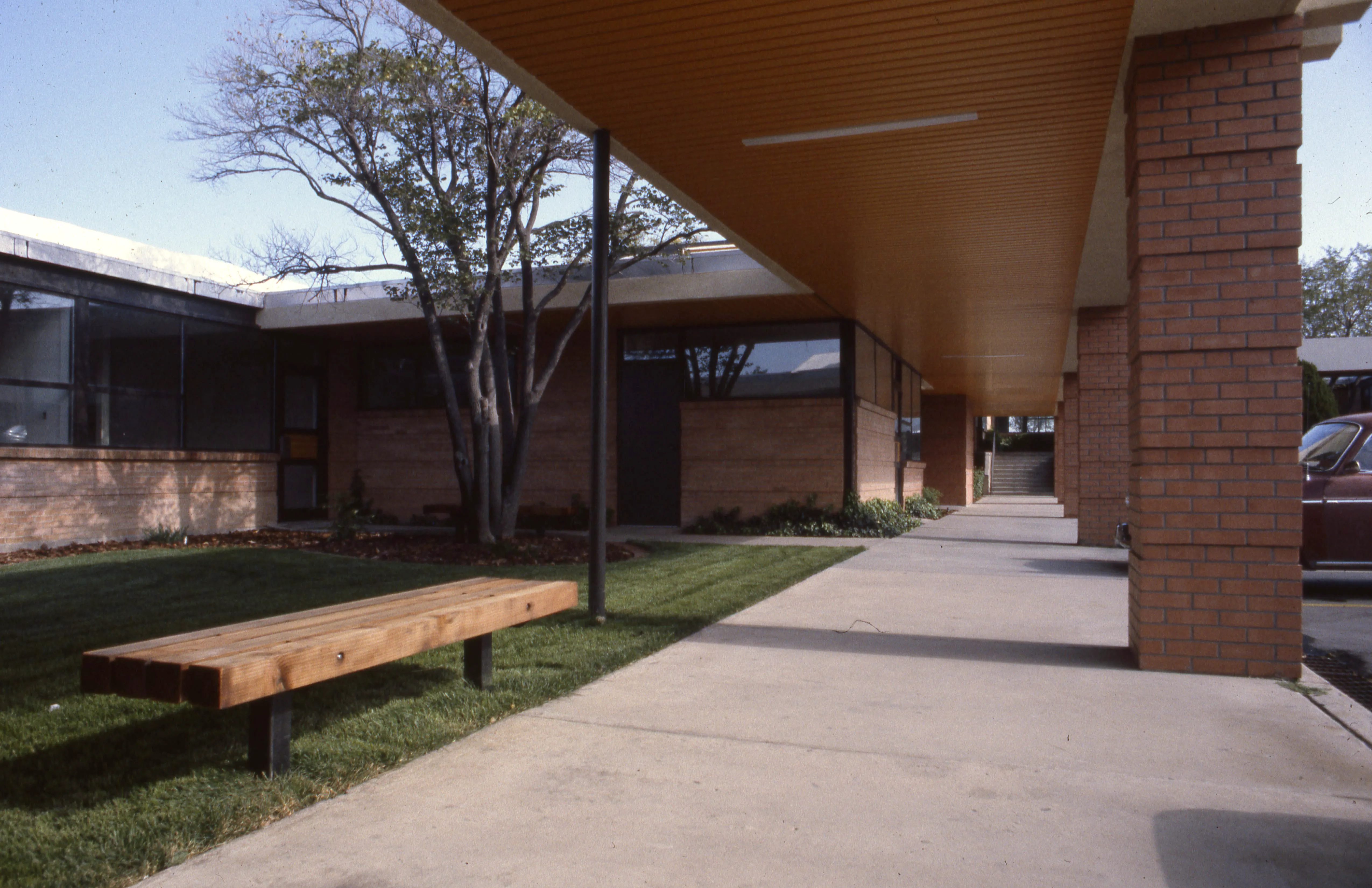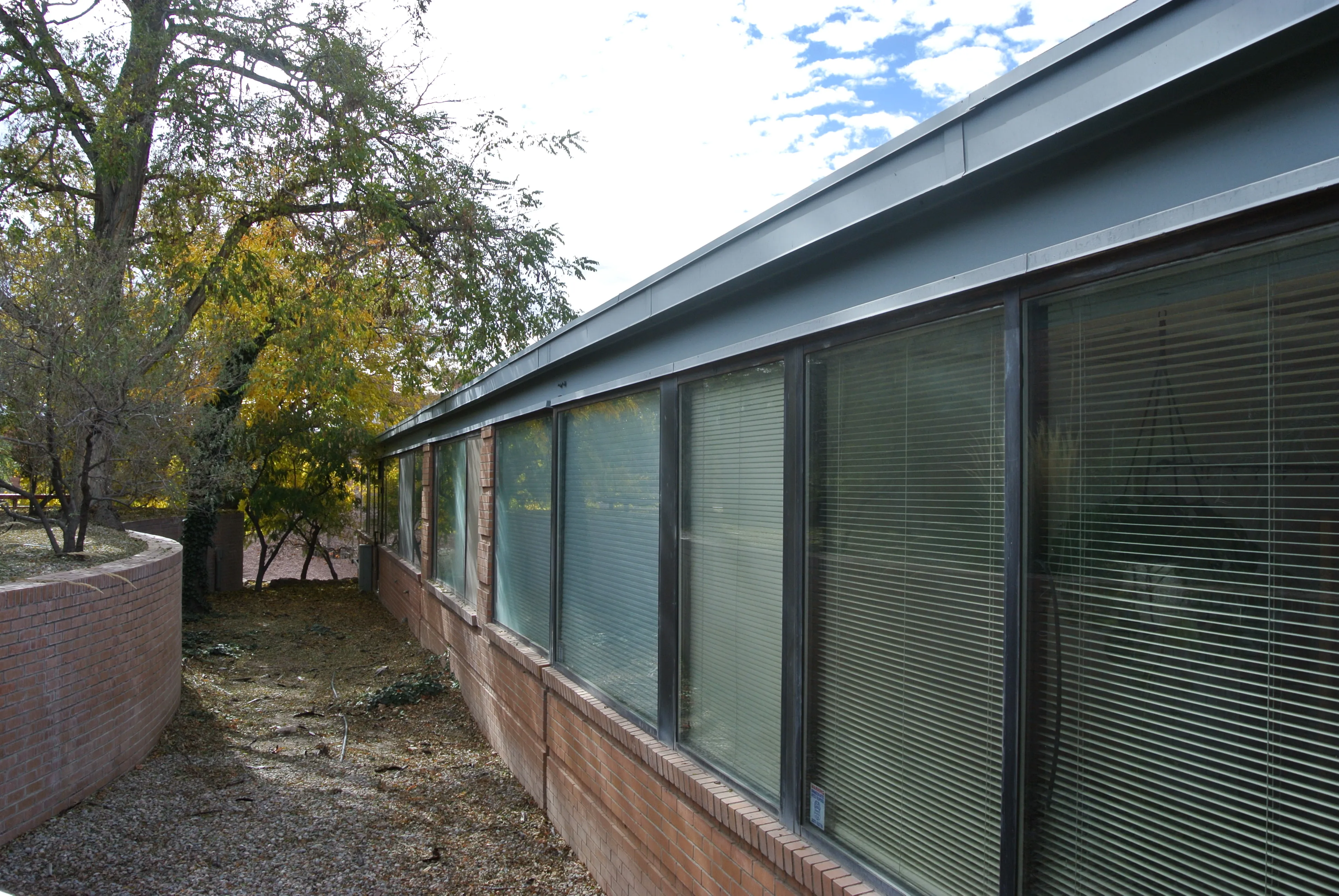1953
Flatow and Moore
Case study by:
Simon Sawyer,Fri Oct 09 2015
Medical Arts Square

Introduction
In 1951, construction began at 801 Encino Place NE to build Medical Arts Square, the nation’s first drive-in medical complex.1 Designed by local modernists Flatow and Moore, Medical Arts Square was built in response to transformations in downtown Albuquerque and enabled the movement of physicians and dentists to a new location of equal distance to the city’s hospitals. The context surrounding Medical Arts Square demonstrates the radical development that was occurring in Albuquerque due to the postwar economic boom as well as the increasing influence of Albuquerque as an architectural hub in the Southwest. Upon completion, Medical Arts Square presented a new approach to medicine in the booming Sunbelt, with over 57,000 square feet of offices housing 60 doctors and dentists, all arranged around a central parking lot on a nearly five-and-a-half acre site.2
Historical Context and Construction
Medical Arts Square was constructed as a result of the changing landscape within Albuquerque in the aftermath of World War II. The First National Bank Building, completed in 1922, was Albuquerque’s largest skyscraper at the time. Designed by Trost and Trost, this building not only housed the Bank of Albuquerque but over the years also became the home of numerous small medical offices. With the decline of downtown as a result of the city’s rapid commercial and residential suburbanization, doctors who had worked in the First National Bank Building approached Flatow and Moore with a scheme for a new, shared office complex.3 Max Flatow, who would become the city’s leading modern architect, was to choose the site and recalled that his selection, isolated on an empty hillside northeast of downtown, looked very bleak to his clients.4 However, the chosen location was just a five-minute drive away from downtown and as convenient to the city’s major hospitals as the doctors’ former offices. It thus fulfilled the clients’ hopes for a new facility that doctors and patients alike could easily access by automobile.5
Design
For this dusty site, Flatow designed something architecturally cutting edge. The complex, completed in 1953, consisted of single-story buildings connected by covered walkways that followed the location’s topography and separated a central parking lot from the medical offices. A building at the Encino Place entrance hid the rest of the complex and dictated the traffic flow in and out of the lot, to its north and south. These buildings together defined a square-shaped plan, as the project’s name suggests, with medical offices around the perimeter of a large parking area. Beyond the simple, pared-down design of the structures themselves, this was the strongest modernist gesture of the project: it unapologetically catered to the new world of Albuquerque in the postwar era, a world defined by the centrality of the car.
Indeed, postwar Albuquerque experienced massive growth in its population and economy. As historian Robert Turner Wood explains, “The number of people residing within the city limits rose from about 50,000 in 1945 to 96,815 in 1950 to 201,189 in 1960.”6 This unprecedented population growth was due to several factors. Many veterans who were stationed in Albuquerque during the war stayed afterwards due to the increase in military jobs available within the city. “The clear New Mexico weather, the excellent conditions of the terrain, and the central location of the city in the south-western United States” likewise explained this growth, Wood writes. “Albuquerque had become a vital link to military communication and [the] air transport network.”7 The increase in military jobs within Albuquerque was linked to the presence of Air Force bases and Sandia National Laboratory, a key part of the nation’s nuclear infrastructure.
The increased population size of Albuquerque became evident through the growth of the city itself, with the area within its boundaries expanding more than fourfold between 1945 and 1950, from 11 to 49 square miles. The demand for new homes from all these residents and the vast, relatively empty land around Albuquerque at the time enabled the construction of massive housing developments, resulting in the city’s rapid expansion. New merchant builders, like Sam Hoffman, led the way. His Hoffmantown, for example, constructed in the city’s northeast quadrant at the same time as Medical Arts Square, was at the time the “largest suburban community in New Mexico, including about 800 new homes and 2,800 residents.”8
Site and Suburban Context
The creation of these entirely new suburban communities and neighborhoods led to the outward movement of businesses too. Into the late 1940s, downtown had maintained its place as the city’s commercial center, but this had begun to change early in the next decade as retail and offices sought to catch up with residents. The movement away from downtown and closer to the new suburbs created a massive expansion of business, as well as new architectural forms. Route 66, or Central Avenue, long the city’s major spine, also dictated this urban transformation as it “began to rapidly accumulate clusters and strips of all kinds of commercial establishments.” Much of this development was focused on the automobiles that contributed to the city’s sprawl. Nob Hill, for example, one of the areas growing quickly during this era, exemplified the new idea of the “drive-in” commercial center with its Nob Hill Business Center (1946-47), a one-story, U-shaped project that, much like the later Medical Arts Square, incorporated a central parking lot and addressed the scale of the automobile. This was just one example of the new commercial districts that were slowly developing around Albuquerque and the freedom that the city’s development approach enabled. As Wood explains, “An entrepreneur or group of entrepreneurs could even, if it had the resources, obtain a substantial piece of land and locate on it a business of its own choosing; such flexibility was harder to come by in the crowded downtown.”9 Indeed, for the Medical Arts Square, this is precisely what had occurred.
The Medical Arts Square was an example of the kind of group or cluster of similar business that had begun to develop throughout Albuquerque, in this case centered on medical services, not retail. A coalition of physicians led by Dr. James Hannett, brother of a former New Mexico governor, backed and owned the project. Rather than seeing their peers as a competitive threat, they – like shop owners who took part in similar projects – viewed the grouping of similar businesses as convenient and thus mutually beneficial to all involved. Their site was located near an area that had long had medical uses. These included St. Joseph’s Sanatorium, Lukens Hospital, and Regina School of Nursing.10 And the completion of Medical Arts Square only accelerated this role as further medical businesses began to move into the area. The development of this “medical district” created a central location that the residents of Albuquerque could easily drive to, where they could access any medical advice or consultation. This part of the city retains this role to the present day. Due to the other medical practices and facilities that have continued to locate around the site, the area gained a nickname: “Pill Hill.”11
Flatow’s design hand contributes to the project’s role as a center for medical services in the city, not merely a strip of offices, while carrying out an ideal of privacy and discretion that fits the project’s program. To an extent Medical Arts Square hides its contents, with adjacent streets – Medical Arts Avenue NE and Las Lomas Road NE – displaying only the back entrances to the medical offices, which sit upon a hill. Only once the Encino Place entrance is reached does the interior of the complex, with its storefront offices, reveal itself.
Yet the location of the site and the views from it make plain Medical Arts Square’s centrality and the importance of easy automobile access to it. Today the entrance to Medical Arts Avenue NE lays directly adjacent to I-25, but even at the time of the project’s construction it lay proximate to major routes like Lomas Boulevard. This location suggests the priority that Medical Arts Square’s backers placed on the convenience of the car and the ability for the greater Albuquerque population to easily reach the offices here. After completion of I-25, one could drive onto the freeway, exit at Lomas Boulevard, and arrive with minutes to a medical appointment. Artistic renderings of the finished project even display the tire tracks made from cars entering and exiting the facility, signifying the importance of the automobile in its planning.
Then and now, visitors are constantly reminded of the convenience of the project’s location. From the boundary of Medical Arts Square, views of the skyline, I-25, and nearby hospitals are present. These visibly show the modest distance from the project to downtown and to other medical facilities. Upon completion, the project stood at the still-developing edge of the city. But today the surrounding area, which is now fully developed, stands in stark contrast.
Architectural Features
Yet despite this automobile orientation and clear attention to the metropolitan scale in the project’s conception, a closer look reveals the care that Flatow and Moore paid to the human scale. The complex itself is separated into six different buildings scattered along the perimeter of the site, connected by a continuous covered walkway that ascends and descends with the terrain, separating the parking lot from the medical offices. From the covered walkway, individual paths are made through small courtyards towards the entrances of each separate office, with covered pathways here too. These courtyards function as moments of relief along the path; many feature benches and prominent trees, creating shade and calm for visitors. Other offices are entered directly from the walkway. Brick columns support the pathway’s coverings, as do thin tubular steel columns organized in accordance with the structural grid and entrances into the offices.
The entire complex visibly follows a modular structure, defined by bays created by the brick columns along the covered walkway. In most cases a bay serves as the space for a single medical office. In other instances, such as for larger offices, tenants employ multiple bays. This organizational principle creates flexibility in the leasing of medical offices, providing the ability to expand or reduce them in size. Despite the top-down approach of the design, a common modernist characteristic, Flatow and Moore enabled the adaptability of space here, to account for changing medical trends and evolving equipment within each business.
Angled skylights, following a sawtooth form, are present in offices that receive minimal sunlight throughout the day. These skylights provide diffused light throughout the rooms and, as seen in early photographs of the interior of Medical Arts Square, sustain plants in waiting rooms. Although these skylights are not present in all of the offices, they add a level of comfort to the space, creating a better environment for the patients and bringing visual interest to the low-slung exterior form.
Conclusion
Over the years, maintenance of Medical Arts Square has changed some elements of its design. Brown steel slats originally clad the underside of the walkway coverings, lending a comforting warmth, but today these elements feature a brighter, more austere white finish. The original design of the project contained a small café, but now that café has been replaced by more offices. The main seating areas have been removed; instead small benches and chairs are scattered around the site. The courtyards that separate the walkway from offices were once planted with grass, but have since been converted to dry landscaping. This can be justified due to growing maintenance costs and the realities of a desert climate.
Exposed I-beams located upon the buildings’ fenestrations create a long shadow that visually separates the exterior walls from the roof. The use of a “floating roof” was one of Flatow’s architectural trademarks, achieved using different means in many of his designs around Albuquerque, such as the Rio Grande Pool and Acoma Elementary School. This design feature aligns itself with the broader modernist trends of the time, including the extensive use of steel and glass, yet Flatow adapted these techniques in his own vocabulary. Though an early project in his career, Medical Arts Square foreshadowed the use of warm materials such as brick, human-scaled spaces, and architecturally ambitious formmaking that became characteristic of his approach.
Medical Arts Square tells the story of a growing Albuquerque. New ideas, rapid population growth, and business expansion characterized the postwar transformation that occurred within the Southwest, which Albuquerque particularly symbolized. Fortunately for the case of modernism, the theories and practices explored in projects like Medical Arts Square demonstrated that new architectural approaches had the potential to adapt to an ever-changing context. As Flatow and Moore showed here, in a complex that has remained functionally useful and formally intriguing for more than fifty years, modernism could improve the lives of the occupants of this booming region.
Footnotes
-
Edna Heatherington Berman, “The Fate of Architectural Theory in Albuquerque, New Mexico: Buildings of Four Decades, 1920 – 1960” (master’s thesis, University of New Mexico, 1978), 254. ↩
-
“Two Practices Expand Into Medical Arts Plaza,” Albuquerque Journal, 10 May 2010. ↩
-
Bergman, 254. ↩
-
Ibid. ↩
-
Ibid. ↩
-
Robert Turner Wood, The Postwar Transformation of Albuquerque, New Mexico, 1945-1972 (Santa Fe, NM: Sunstone Press, 2014), 66. ↩
-
Ibid., 67. ↩
-
Ibid., 70, 108. ↩
-
Ibid., 109, 115. ↩
-
Ibid. 115-116. ↩
-
“Two Practices Expand into Medical Arts Plaza.” ↩

